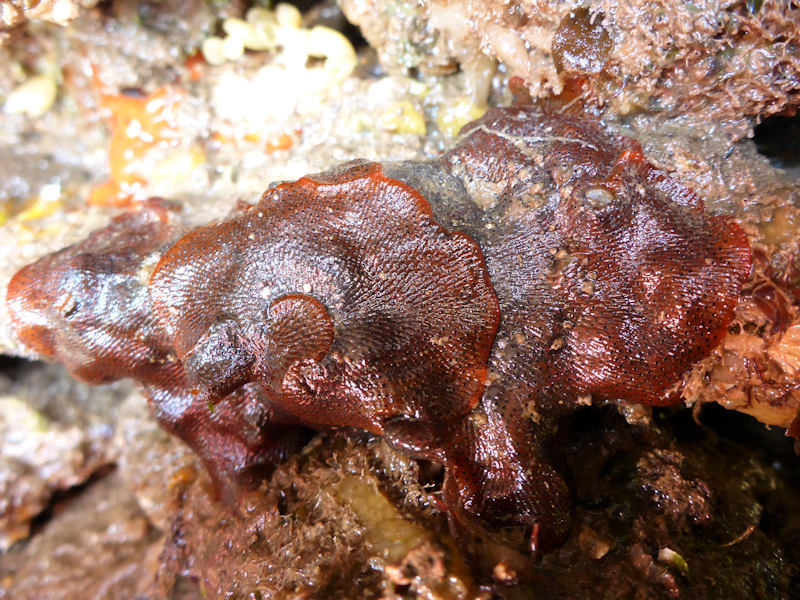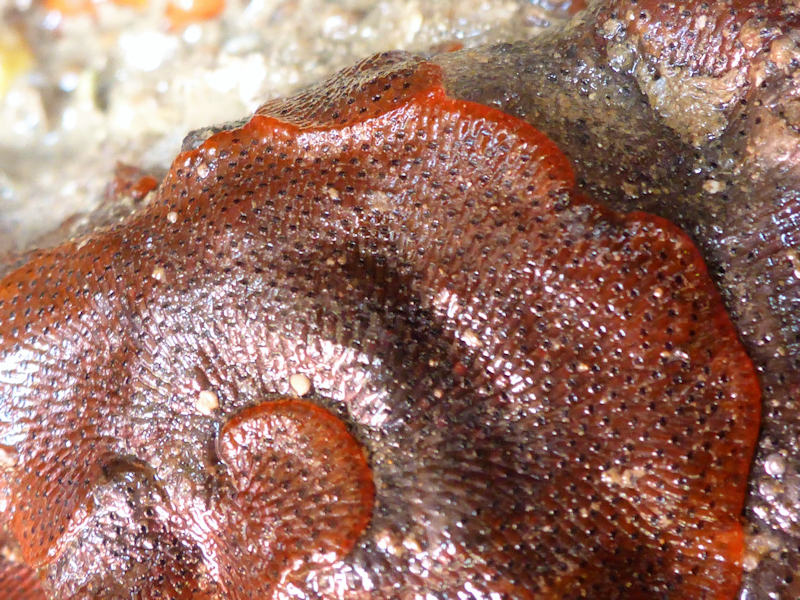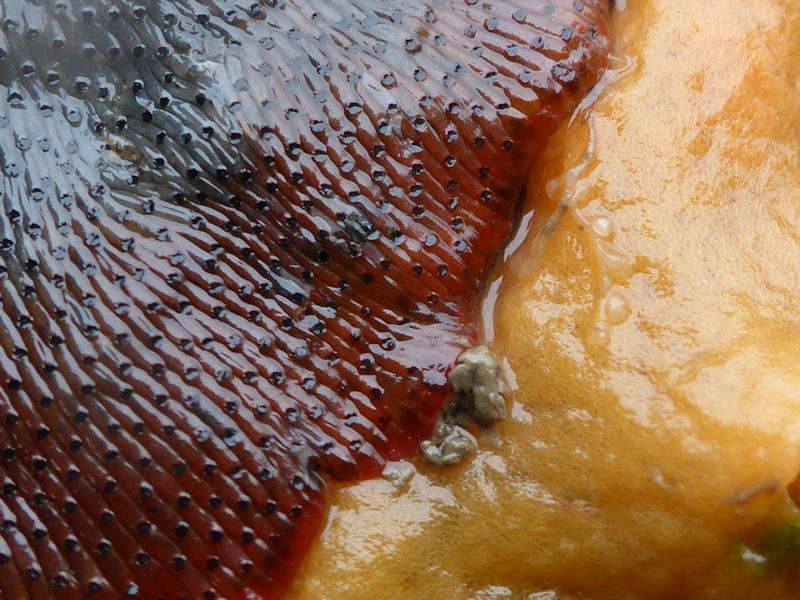Red ripple bryozoan (Watersipora subatra)
Distribution data supplied by the Ocean Biodiversity Information System (OBIS). To interrogate UK data visit the NBN Atlas.Map Help
| Researched by | Chloe Wilson | Refereed by | Admin |
| Authority | (Ortmann, 1890) | ||
| Other common names | A sea mat | Synonyms | - |
Summary
Description
The encrusting bryozoan Watersipora subatra colonizes a range of hard substrata from rocks and shells in shallow water, to boat hulls and pilings. Its growth form varies with the age of the colony. Young colonies are small, flat and almost circular. As a colony develops, it may grow over itself giving the appearance of a rippled surface. Well established colonies can be erect and often leaf-like (foliaceous), forming lobes and frills that extrude from the substratum. Watersipora subatra is typically red or orange in colour but may be purplish-brown, black or grey with lighter edges where the younger zooids are found. The roughly rectangular zooids are organized into tightly packed lines that radiate out from the first colonizing zooid (ancestrula). Each zooid bears a single large orifice that has a pronounced U-shaped indentation. The frontal surface of each zooid is slightly convex and covered with false pores (pseudopores).
Recorded distribution in Britain and Ireland
Recorded along the south coast of England, from Plymouth to Portsmouth and in Pembrokeshire. Unpublished records expand this range to include sites between Newlyn and Eastbourne, as well as Guernsey and, Dublin, Ireland.
Global distribution
Outside the UK, Watersipora subatra has a scattered distribution with colonies reported in the northern Mediterranean from Turkey to Spain. Additional observations have confirmed its presence in northern and western France and on drifting seaweed at Helgoland, North Sea. Globally, Watersipora subatra is not restricted to temperate waters, with colonies found in Indonesia, Africa, the USA, Australia and New Zealand.
Habitat
Colonizes a variety of hard substrata, most commonly in the lower intertidal and shallow subtidal but can be found to depths of 10 m or more. Colonies establish on both natural and manmade surfaces including docks, vessel hulls, floating debris and rocks and shells. As an early successional species, Watersipora subatra is particularly efficient at colonizing the novel habitats provided by artificial structures.
Depth range
Lower Intertidal - Shallow SubtidalIdentifying features
- Subrectangular to hexagonal zooids, approximately 0.4 - 0.7 mm x 0.3 - 0.5 mm.
- Morphology varies from small and round to erect foliaceous structures.
- Orifice is subcircular or oval with a defined U-shaped sinus.
- Operculum has a biconcave band across its centre.
- A pair of grouped perforations in the zooid wall (intrazooidal septula) are present either side of the orifice, each consisting of 3-8 small pores.
- Bar shaped condyles (pair of outgrowths on which the operculum pivots).
- Avicularia absent.
- External surface of zooids is convex and is covered with pseudopores.
Additional information
Watersipora subatra is an invasive species of unknown origin, although the Gulf of Mexico has been suggested as a potential native range. It was formerly misidentified as the species Watersipora subtorquata by some authors. It is now believed that Watersipora subatra is the predominant species of this genus found in the UK, whilst Watersipora subtorquata is the most common species in the subtropical and tropical waters of the Mediterranean and Atlantic.
Listed by
- none -
Bibliography
GBNNSSIP., 2017. Watersipora subatra. Factsheet. [online]. York, GB Non-native Species Secretariat. Available from: http://www.nonnativespecies.org/factsheet/downloadFactsheet.cfm?speciesId=3748 [Accessed: 02/11/2017]
Porter, J., 2012. Seasearch Guide to Bryozoans and Hydroids of Britain and Ireland. Ross-on-Wye: Marine Conservation Society.
- Tidbury, H., 2015. GB Non-native Organism Rapid Risk Assessment for Watersipora subatra. Cefas (unpublished)
- Vieira, L.M., Jones, M.S. & Taylor, P.D., 2014. The identity of the invasive fouling bryozoan Watersipora subtorquata (d’Orbigny) and some other congeneric species. Zootaxa, 3857 (2), 151-182.
Datasets
Centre for Environmental Data and Recording, 2018. Ulster Museum Marine Surveys of Northern Ireland Coastal Waters. Occurrence dataset https://www.nmni.com/CEDaR/CEDaR-Centre-for-Environmental-Data-and-Recording.aspx accessed via NBNAtlas.org on 2018-09-25.
Fenwick, 2018. Aphotomarine. Occurrence dataset http://www.aphotomarine.com/index.html Accessed via NBNAtlas.org on 2018-10-01
NBN (National Biodiversity Network) Atlas. Available from: https://www.nbnatlas.org.
OBIS (Ocean Biodiversity Information System), 2025. Global map of species distribution using gridded data. Available from: Ocean Biogeographic Information System. www.iobis.org. Accessed: 2025-07-30
Citation
This review can be cited as:
Last Updated: 02/11/2017
- Bryozoan
- Bryozoa




.jpg)

